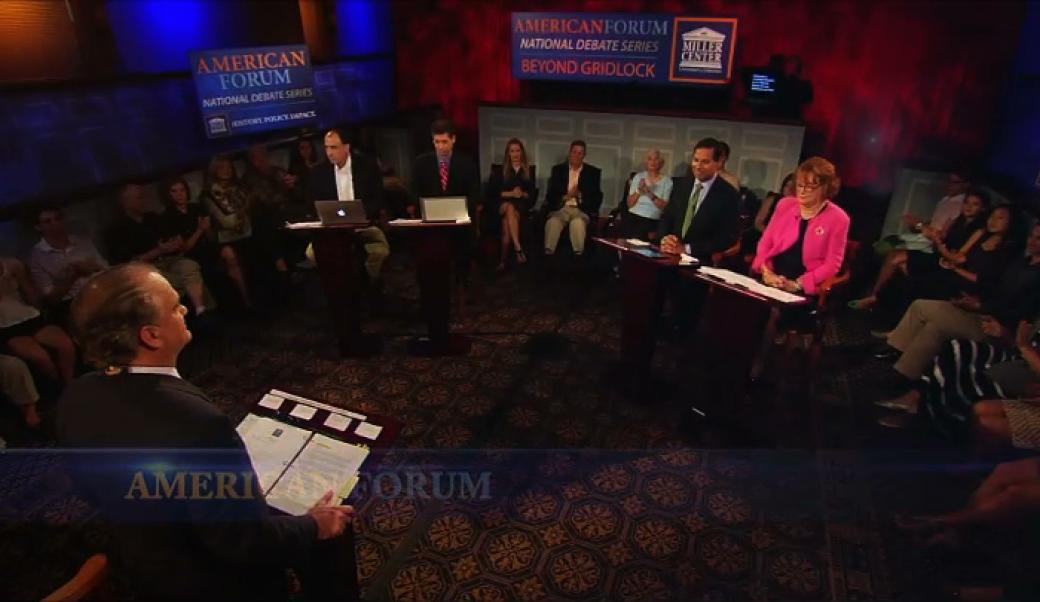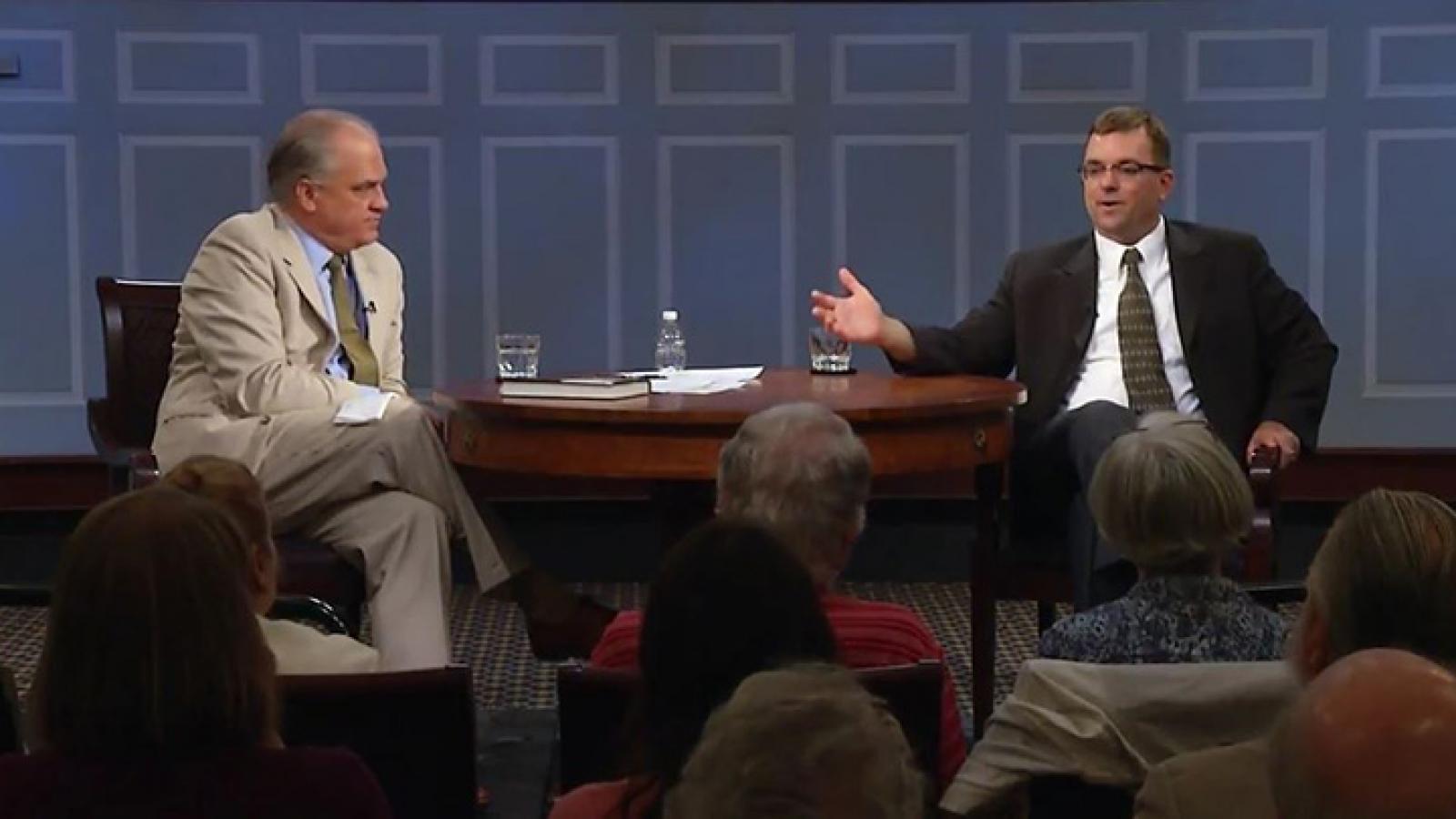About this episode
May 06, 2016
Andrew Highsmith
Andrew R. Highsmith is an assistant professor at the University of California, Irvine, and a specialist in modern U.S. history with particular interest in policy, racial and economic inequalities, and public health. His first book, "Demolition Means Progress: Flint, Michigan, and the Fate of the American Metropolis," explores the spatial and structural barriers to racial equality and economic opportunity in metropolitan Flint from the early 20th century to the present. In this episode, he discusses the water crises in Flint.
Health
How did the Flint crisis happen?
Transcript
0:41 Doug Blackmon: Welcome back to American Forum. I’m Doug Blackmon. In the spring of 2014, troubled Flint, Michigan, hoping to save some money, began pumping its drinking water out of the River flowing through the center of the city, a place 75 miles from Detroit, that had once been a powerhouse of American auto-making and industrialism. Citizens immediately complained that the water looked and smelled bad. State and local officials insisted it was fine. Until 18 months later, testing revealed conclusively that the water didn’t just stink, it contained high levels of lead, and thousands of city residents, especially children, may have been seriously poisoned through the incompetence or malfeasance of public servants. Michigan's Republican Governor Rick Snyder has been imperiled by the controversy. Government workers have been criminally indicted. President Obama and Democratic presidential candidates seized on the city’s public health crisis as an example of our country’s abandonment of poor people. But what is the real origin of a public policy train wreck like the water crisis in Flint?
FACTOID: The Question: who’s to blame for Flint’s lead water crisis?
Is it callous political leaders, incompetent government technicians, corruption, or something much deeper? In this episode, we’ll try to answer that. Our guest is Andrew Highsmith, a history professor at the University of California, Irvine, who long before the water crisis was studying what happened in Flint Michigan over the past 50 years, and how it fits into the broad decline of so many urban areas in America. He’s just published a new book, titled, Demolition Means Progress: Flint, Michigan and the Fate of the American Metropolis. He says the crisis in Flint is rooted in decades of failed urban renewal efforts, questionable corporate conduct, and the often misunderstood reality of racial segregation in the North and Midwest. Andrew, thank you for being here.
Andrew Highsmith: Thank you for having me.
2:37 Blackmon: So who’s fault is what has happened in Flint Michigan?
Highsmith: Well the truth is that there is enough blame to go around. The blame has to start with Governor Rick Snyder who declared Flint’s financial emergency in 2011 and subsequently uh appointed the uh series of four emergency managers who have effectively governed the city over the past five years and so Governor Snyder and he’s he’s owned his share of the blame uh in recent months uh.
FACTOID: Rick Snyder became Republican governor of Michigan in 2011
Also those emergency managers he appointed to uh had who oversaw the uh uh switch to the Flint River. Uh but also there are failures and missteps of all levels of government. The EPA was lax in overseeing its lead and water rules and so too was the Michigan Department of Environmental Quality. And so there is enough blame to be spread uh across uh different levels of government: local, state, and federal. But the truth is that if we want to understand Flint’s uh lead and water crisis, we also have to dig much deeper to a variety of other forces, many of the structural in nature uh that have led and contributed to this water crisis. And what I mean by that is that if we want want to understand why it was that Flint was in this State of Emergency in 2011, we have to go back a couple of generations to think about uh uh the changes in the city that occurred over that period in particular, two key migrations, both of them government sponsored. The first of those was the migration of the industrial capital in particular uh General Motors uh factories from the cities to the suburbs and rural areas and over time, this out migration of factories from the central city helped to contribute to a massive economic crisis in the city that helped to lay the groundwork for this emergency declaration.
FACTOID: General Motors was Flint’s Biggest employer during most of 20th century
Uh but it’s also important to understand why this lead and water crisis had such a disproportionate effect on people of color and the poor and to understand that we also have to dig back uh several generations to think about um racially discriminatory housing and urban develop, development policies in particular that have kept many African Americans locked inside the central city.
Blackmon: But let’s go back, let’s dig in to some of that. I mean the first big migration that you just refereed to is uh broadly speaking the great migration of African Americans from the South to to the North and then the uh and the way that it was that Midwestern cities and northern cities received this massive movement of African Americans began just before World War II an just after uh headed for the hope and opportunity that seemed of these places the that obviously were vastly better than the conditions that they were leaving in the deep South so that’s what leads to this giant population of African Americans being in these places.
FACTOID: African Americans made up 56% of Flint’s total population in 2010
But you just referred to this another migration of government um you said sponsored of proved or engineered but the movement of factories out of the cities and into the suburbs. How was it that, I mean that sounds like just a business decision that a company made that wed be wed be smarter to have our factory out there. So what’s the government role in that having happened?
Highsmith: Government at all levels endorsed these types of migrations during the decades following World War II uh prior to World War II, virtually all of GM’s industrial infrastructure in Flint and Genesee County was located inside the city limits in, in the city of Flint.
FACTOID: During the ‘second great migration,’ 5 million black Americans moved north
Uh but really from 1940 to 1960, GM uh embarked on a new suburban investment strategy in Genesee County, and as part of that suburban investment strategy, they build eight new industrial complexes, all of them in the racially segregated suburbs surrounding the city. And in doing so there were a variety of different reasons for them shifting that capital from the city to the suburbs. Some of it was about that fact that Flint had very little space left for industrial development, it was a very densely packed city at the time. But there were other factors in play as well. At the local level the city actually subsidized those shifts from the city to the suburbs by granting water extensions and sewer extensions to those plants. Uh and it that might seem surprising at first blush, but the truth is that city officials believed that industrial development anywhere in the metropolis was a benefit to everyone in the metropolitan area. And they also were eyeing those plants for annexation and ultimately reached the government. But those plants failed. And so ultimately the plants that shifted from the city to the suburbs were lost to the city. As fears over nuclear annihilation spread during the post war period, the federal government encouraged the decentralization of industry from central cities to suburbs and rural areas. And the idea was that they wanted to keep factories in industrial centers safe in the event of a nuclear attack and so they encouraged the migration of defense producers like General Motors to areas outside of central cities and they did that by offering very generous tax breaks for the construction of new plants. When we think about Flint’s trajectory over the past few generations, not only Flint, but also cities like Detroit and others who have experienced the industrialization. We often tell those stories as ones of decline, from some golden moment in the past.
FACTOID: Detroit’s population declined from 1.8 million in 1950 to 680,000 in 2014
Uh a downward trajectory toward the industrialization and urban decline and so forth. And what I discovered in doing research for the book is that narrative is a narrative that revolves too narrowly around the experiences of white working class people and in particular white working class men, because there really never was a golden era for people of color or women in cities such as Flint, this was a period even though there was um you know, jobs were somewhat plentiful and employment rates were low, this was also a period of very rigid racial segregation and of a very uh sharply delineated opportunity structure uh for tens of thousands of Flint residents. And I think that um these stories that we often tell of the decline of the so called rest rust built sometimes mask that uh divergent experience.
9:12 Blackmon: We look at a place like Detroit or a place like Flint and the terrible decline that it had, and we think of it as, we see it as something, as a place where giant macro forces of the economy simply, the winds of time, and the winds have changed simply turned against this place. And it turned out so badly because the industry moved away. But, you make the argument here that many of these, these terrible developments were actually the result of, of a constructive effort. I mean an effort where somebody’s saying the way to have progress, the way to move forward, is to do x, y, and z. But, it turns out that the consequences of doing x, y, and z are fairly catastrophic for a whole lot of people
Highsmith: Uh,“Demolition Means Progress” comes from the signs that GM used to place in front of its shuttered automobile plants in cities such as Flint and the signs suggested that cities such as Flint couldn’t really move forward to civic greatness until these old, closed plants met the wrecking ball. And I, I still remember the first time I saw one of those signs shortly after I moved to Flint and at first I thought, well this is a very trite, uh, corporate slogan and in many ways it was. But, as I started to dig in to Flint’s history, I realized “Demolition Means Progress” was also a very powerful metaphor for thinking about the city’s long history of revitalization. And so rather than thinking about Flint’s economic changes through the lens of decline, I’ve tried to narrate Flint’s history and also urban America’s history more broadly as one of revitalization and its consequences. And what I mean by that is that dating back to the 1920s and 30s, Flint’s civic and political and economic leaders looked to constantly revitalize the city by enacting different redevelopment policies and so in the 1930s, uh, public school officials and industrial executives collaborated to transform all of the city’s public schools into racially segregated, vocationally oriented elementary schools and community centers. Flint’s leaders constantly look to demolish and tear down what they perceive to be outdated or inefficient structures and institutions and rebuild them to be more profitable. And so during the 1940s and 50s, the city, or GM executives, were tearing down old urban plants and rebuilding them in the suburbs and when those efforts didn’t create a renaissance, the city looked to tear down African American neighborhoods and replace them with the freeway, and new factories, and public housing. And as I narrate in the book, this long string of revitalization efforts ultimately contributed to Flint being one of the most racially segregated, economically polarized, and politically fragmented regions in the nation. And so even in the 1960s and 1970s, right, the era of Civil Rights, GM is still being referred to as “GM Crow” by civil rights activists in the city. And GM, even in the era of significant environmental reforms and legislation, is still heavily polluting adj, neighborhoods adjacent to its factories, neighborhoods populated by and large by African American people. And so it’s one thing to, to put, you know, actors of the early twentieth century into their proper historical context. It’s another to excuse actions, discriminatory actions, that occurred deep into the twentieth century and beyond.
12:41 Blackmon: At a time when people should have known better, as a simple enough way to say it? Again we’re trying to tie this into the Flint water crisis but is this also part of, is this how we understand what happened in Ferguson, Missouri, or how we understand what has happened when there have been big violent events in Los Angeles or in Baltimore. I mean is is that part of the more national story that the same kinds of sequences of events or Camden, New Jersey or Newark, New Jersey?
FACTOIDS: Ferguson riots triggered by killing of black teenager by white officer
Highsmith: Absolutely, I think that I mean if we think about uh the history of Ferguson for example. Ferguson initially was an overwhelmingly if not all white suburb of St. Louis. Uh but that suburb transitioned over time to a black majority due in large part to public policies, public policies related to subsidized housing that funneled African Americans from St. Louis, from north St. Louis in particular into re segregated neighborhoods in Ferguson and elsewhere.
FACTOID: Ferguson’s white population fell from 75% in 1990 to 33% in 2010
And these types of um, these types of policies were in evidence not only in Ferguson or Flint but all across the country. So I think that that historians like me can offer us a longer chronology for thinking about the emergence of these sorts of crisis in the 21st century.
It is impossible to understand Flint’s economic crisis without understanding the deindustrialization of the city. Flint, to give you a sense of some of the transformation that occurred there. Flint at its peak in the 1950s had about two hundred thousand people inside the city, another couple hundred thousand in the suburbs so nearly a half million in the metropolitan area. Eighty thousand people worked for General Motors during this peak period so virtually half of the city’s population working for GM during this period but over the course of the second half of the 20th century, of course many of those jobs vanished. In particular beginning during the 1980s and ’90s and such that by the turn of the 21st century, the city had fewer than ten thousand jobs left so a loss of around 75 thousand GM jobs in Genesee in the past 65 years and those losses have been felt in dramatic ways in higher, astronomical rates of unemployment. In home foreclosures and vacancies, in a sharply declining tax base, in decreased funding for the public schools and so its impossible to understand Flint’s economic transformation. It’s impossible the declaration of financial emergency without understanding the ravages of deindustrialization.
FACTOID: Population of Flint, Michigan had fallen to just over 99,000 by 20134
FACTOID: Flint unemployment rate of 10.2% is nearly twice national average
15:20 Blackmon: Is there some sort of scenario under which General Motors would have remained in this place, and this could have remained a prosperous place at the same time the Japanese auto makers were emerging from the ashes of World War II and global forces were so powerful? I mean is there actually a significantly different sequence of events that could’ve happened?
Highsmith: So I’m not accustomed to answering counter factual or questions like that but for the sake of this conversation let’s do it. Um, I think that that yes and no. Part of the problem with GM in the late 20th century was that there was a certain hubris among local executives about um the preference for large, gas guzzling automobiles. Even though evidence in the 1970s was suggesting that that people in large numbers were turning toward smaller more fuel efficient cars. Executives in Flint and Detroit looked at those shifts as signs of a delusion among consumers and believed that they would ultimately always go back to the GM’s staple large cars. So part of the problem that GM faced was due to those failures of imagination among its corporate executives. And yet there’s also a sense in which things could’ve turned out differently, at least for a time, in metropolitan Flint. And this is where the fifth chapter of my book on this failed new Flint plan is extremely important because as I said GM is relocating all these plants outside of the suburbs but they want to have those plants returned to the city. Now if can you imagine if they were successful in either annexing or creating that regional government, Flint’s industrial infrastructure would have been extremely impressive. One of the most impressive in the United States. And many of those plants in the suburbs are still open today. And so the timing of Flint’s industrial crisis would have been shifted much later had the city been able to annex those plants or capture them through regional government. But the truth is that alongside of all these local forces that could have shifted the outcome there were also much larger global forces driving GM executives to seek out low wage opportunities in other parts of the country and the world. But one of the ironies of ironies of Flint’s economic crisis is that over the last 20 years, civic leaders um, um, in the city have been advertising Flint as something of a low wage haven. As a place you can come in and set up shop and pay a two-tier wage structure where the UAW is not going to cause any problems for you. They’ve been able to market themselves kind of the way that old cities in the South in the Sunbelt did following World War II as lower wage sectors that are amenable to the business and investment. And one of the ironies of Flint’s story is that prior to the water crisis, GM had actually invested substantially in so new industrial infrastructure in Flint. They built a new engine plant, a new paint facility. Now those new facilities didn’t create large numbers of jobs for local workers but they were certainly signs that GM had not abandoned the city as you said, but rather was looking everywhere for new opportunities wherever they could meet the bottom line.
18:45 Blackmon: This discussion of how global forces and also government policy, right or wrong, um came to bear on these economic decisions made by these companies, these unforeseen consequences it, that’s the more sophisticated way of saying it I think, but it sounds a bit like the way that uh Donald Trump or Bernie Sanders would talk about the effect of globalization on America in a bigger sort of way. Companies taking their factories and jobs, outside of the U.S. and government policy that they would contend facilitated that and accelerated that and in a sense I’m just, it seems like in a smaller, kind of microcosm that there’s a somewhat similar kind of discussion here.
Highsmith: Sort of. I think that uh I noticed in following the coverage of the Michigan primaries and other races that that Bernie Sanders and Trump to a certain extent as well uh really honed in on the issue of free trade and NAFTA in particular in articulating a critique of the policies that lead to deindustrialization uh you know the economic crisis in Detroit and Flint.
FACTOID: Donald Trump, Bernie Sanders won Michigan primaries in April 2016
The truth is though that while, while NAFTA is certainly has certainly lead to the outflowing of jobs from places like Michigan uh the industrial crisis of Flint and Detroit existed long before NAFTA (Blackmon: Yeah). And so I think we need to resist the temptation to find single causes for complex problems like deindustrialization. NAFTA certainly plays role, uh but so too do the other forces that I was writing about in the book.
20:14Blackmon: And ultimately the way that all of this comes to bear on this terrible decision in this one city to change its water supply this you know fairly small decision in a way, that big in this one place, but one small decision, one of thousands made by various city governments the same day of similar scale, but the way that all of this comes to bear on that is that ultimately it is by the uh impoverishing of this place it is the loss of its community resources in a sense. The loss of a of a, a leadership class of some sort or leadership structure of some. But it’s through this general deterioration of the of the social fabric of a place that that leads to simply a context in which it’s more likely that a really stupid decision can be made and there are not forces or people in play to stop it or realize what is happening in time. I mean that’s what it’s that’s what this boils down right? It’s by the depletion of a place like Flint that its then set up for whatever the mistake might be whether it’s a water crisis, or a bad bond issue, or a huge financial mistake.
Highsmith: Right, well I think structurally Flint was set up for this kind of a crisis I mean as I talk about in the book the disinvestment and the, the, the uh depopulation of the city created grave infrastructure crisis. The city, the tax space has been eroded in Flint that it’s virtually impossible for city officials to impair or even maintain the city’s increasingly decrepit infrastructure. So structurally the city’s long term economic crises set the stage for this infrastructure uh difficulty. But uh in terms of this the, the forces within the city, I wouldn’t say that um the uh the broader economic crisis has eroded the social fabric. In fact, one of the things that I’ve been most impressed by in following events locally in the wake of the water crisis is how dogged local activists have been in organizing even when no one was paying attention. It’s interesting to note that really this crisis has been unfolding for a couple of years now and activists there have been mobilizing persistently uh for water justice over that time they weren’t getting a lot of traction, but it’s actually I think created new opportunities for organizing and new opportunities uh for social cohesion across the color line because of course many whites are involved with this as well and one of the other interesting outgrowths of the water crisis, I think, is that it’s actually created new opportunities to connect infrastructure with the broader black lives matter movement that has been sweeping the nature and indeed activists in Flint have been doing just that.
23:05 Blackmon: If after the next election the next president whoever he or she is wanted to talk to some historians and get some sort of perspective on uh on issues like how the infrastructure questions for the whole country have arrived to where they have and if the president of the United States called you in and said Andrew I got I’ve got ten minutes what’s the one thing or the two things that I really need to most understand about what happened in Flint, Michigan for me to do a better job addressing these kinds of issues as President of the United States. What would you tell that president?
Highsmith: What I would say over and over again to the next president is that you cannot cut your way out of urban economic crises and social inequality. We tried it in places like Flint and look where it got us, instead I think that the Flint Water Crisis and the crises in so many of our urban centers that are also significant um require us to invest. And the interesting and exciting possibility that Flint presents is the, the opportunity to link investment and infrastructure with investment in new jobs because all of the city’s water lines are going to need to be replaced and that’s going to create new jobs, new higher paying jobs, and hopefully many of those jobs will go to Flint residents, uh but government officials are going to have to ensure that that happens so new investment in infrastructure, new investment in jobs, and new investment in education because if we don’t do that then at some point down the road we’re going to go back to Flint. And maybe it won’t be lead in the water next time maybe it will be a collapsed school or a bridge in Detroit so the lesson I think of the Flint water crisis is that you can’t cut your way out of crisis and we need to look to new investment.
Blackmon: Andrew Highsmith thanks for being with us. (Highsmith: Thank you) The book is Demolition Means Progress: Flint, Michigan and the Fate of the American Metropolis. We hope you’ll continue this conversation not just about Flint, Michigan but about all the big questions in American life that’s what our program is about. We can all make more sense of the issues that face us and our national leaders if we take the time to understand our history, listen to each other with civility, be open to hearing about both the great things we’ve done as a country and the mistakes we’ve made. So talk to us at the Miller Center Facebook Page or by following us on Twitter @DouglasBlackmon or @AmericanForumTV. To send us a comment, watch other episodes, download podcasts or read a transcript of any episode visit our new webpage millercenter.org/americanforum. I’m Doug Blackmon, see you next week.




